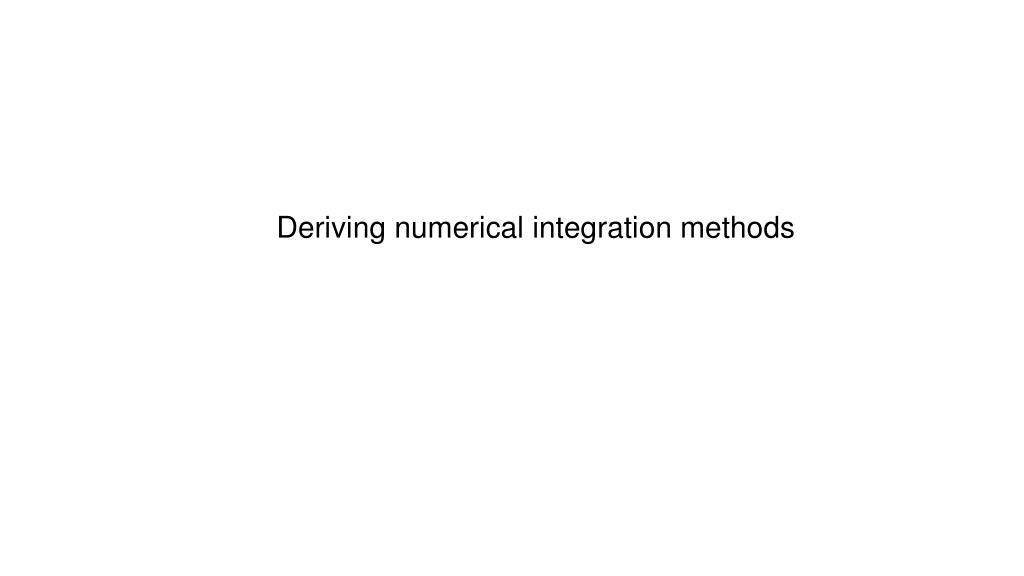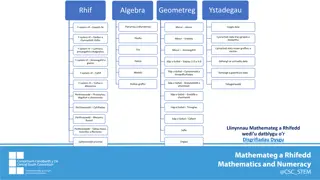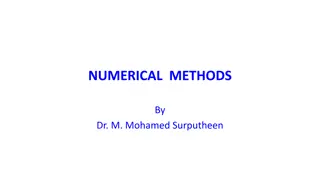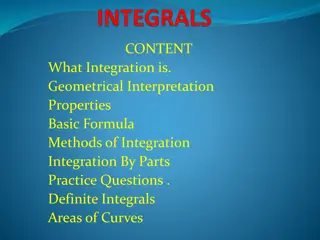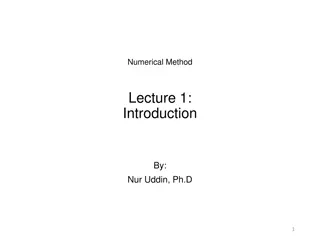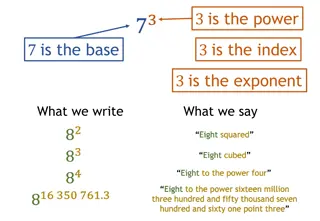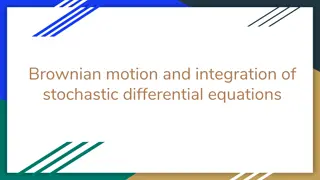Deriving numerical integration methods
Most numerical integration formulas involve a weighted average of the integrand values. One approach is to approximate the integrand with a polynomial, integrate it, and derive the integration formula. This method is demonstrated with examples such as the composite trapezoid rule and Simpson's rule. By approximating the integrand with polynomials of different degrees, formulas for numerical integration can be derived and generalized.
Download Presentation

Please find below an Image/Link to download the presentation.
The content on the website is provided AS IS for your information and personal use only. It may not be sold, licensed, or shared on other websites without obtaining consent from the author.If you encounter any issues during the download, it is possible that the publisher has removed the file from their server.
You are allowed to download the files provided on this website for personal or commercial use, subject to the condition that they are used lawfully. All files are the property of their respective owners.
The content on the website is provided AS IS for your information and personal use only. It may not be sold, licensed, or shared on other websites without obtaining consent from the author.
E N D
Presentation Transcript
As was the case for the composite trapezoid rule, most numerical integration formulas have the form of a weighted average of values of the integrand. = a 0 k b n = ( ) ( ) f x dx f x k k One approach to deriving such formulas is to replace the integrand by a polynomial. Find the equation of the polynomial and integrate it. For example, trapezoid rule with 2 points. Do on board
replace integrand with line (polynomial of degree = 1) 2 This example illustrates that any numerical integration formula that evaluates the integrand at n+1 point will be exact for a polynomial of degree n because we have enough information to find the polynomial and integrate it analytically. However, this approach to deriving numerical integration approximations is hard to generalize to polynomials of degree higher than 1.
Derive the Simpsons rule approximation for numerical integration Approximate the integrand by a parabola (polynomial degree 2) Divide the range of integration into pairs of subintervals of equal width. Develop a system of equations for the weights in the average of integrand a b n = k = ( ) ( ) f x dx f x values by requiring the formula k k 0 to be exact for f(x) equal to 1, x, and x2. Do on board
Derive Simpsons rule with 1 pair of subintervals for range of integration [-a,a] Find weights that give exact results for polynomials up to degree 2 by requiring it to be exact for
Assignment 7 - Find values for weights , , and by requiring the formula to be exact for f(x) = 1, f(x) = x, and f(x) = x2.
Composite Simpsons rule: Generalized this result for 1 pair of subintervals on [-a, a] to n pairs of subintervals on [a, b], where we donote the width of subintervals as h.
MATLAB code for composite Simpsons rule: Layout of points when npairs = 4, npts = 2(npairs)+1 = 9 h = (b-a)/2(npairs) i=0 1 2 3 4 5 6 7 8 |-----|------|-------|-------|------|-------|------|-------| n=2npairs=8 a a+h b Do on board
MatLab code for composite Simpsons rule: 4 pairs of subintervals i=0 1 2 3 4 5 6 7 8 |-----|------|-------|-------|------|-------|------|-------| npoints = 9 a a+h b function A = simprule(fh,a,b,npairs) n=2*npairs; %number of sub intervals h=(b-a)/n; sum_even=0; for i=2:2:n-2 sum_even=sum_even+fh(a+i*h); end sum_odd=0; for i=1:2:n-1 sum_odd=sum_odd+fh(a+i*h); end A=h*(fh(a)+4*sum_odd+2*sum_even+fh(b))/3; end
Download composite Simpsons rule from the class web page. Write a script for the problem Approximate the integral 10 sin( x 3 100 1 )dx x by composite trapezoid and Simpson s rules with 3 and 5 points. Report the absolute percent difference from the exact value of -18.79829683678703 in each case. What is wrong with this script? How do you fix it? integrand=@(x) sin(10/x)*100/x; exact= -18.79829683678703; for npts=3:2:5 T=ctraprule(integrand,1,3,npts) S=simprule(integrand,1,3,npts) pdT=100*abs((T-exact)/exact); pdS=100*abs((S-exact)/exact); disp([npts, T, pdT, S, pdS]); end Why no ./ ?
Download composite Simpsons rule from the class web page. Write a script for the problem Approximate the integral 10 sin( x 3 100 1 )dx x by composite trapezoid and Simpson s rules with 3 and 5 points. Report the absolute percent difference from the exact value of -18.79829683678703 in each case. integrand=@(x) sin(10/x)*100/x; exact= -18.79829683678703; for npairs=1:2 ntps=2*npairs+1; T=ctraprule(integrand,1,3,npts) S=simprule(integrand,1,3,npairs) pdT=100*abs((T-exact)/exact); pdS=100*abs((S-exact)/exact); disp([npts, T, pdT, S, pdS]); end
Assignment 8: Approximate the integral 3 100 10 1 sin( )dx x x by composite trapezoid and Simpson s rules with 3, 5, 7,and 9 points. Report the absolute percent difference from the exact value of -18.79829683678703 in each case.Hand in a copy of command window that shows your script for using the composite trapezoid and Simpson s rules and the results.
Let {x0, x1, , xn} be n+1 points on [a, b] where integrand evaluated, then the numerical integration formula n f(x)dx a Will be exact for polynomials of degree at least n. Derive weights by a system of n+1 linear equations obtained by requiring the formula to be exact for f(x) = 1, x, x2, xn b = = k ( ) f x k k 0 Trapezoid rule: (n = 1) exact for a line In general, error proportional to |f ( )| Simpson s rule: (n = 2) exact for a cubic In general, error proportional to |f(4)( )| How is this extra performance (cubic) possible?
